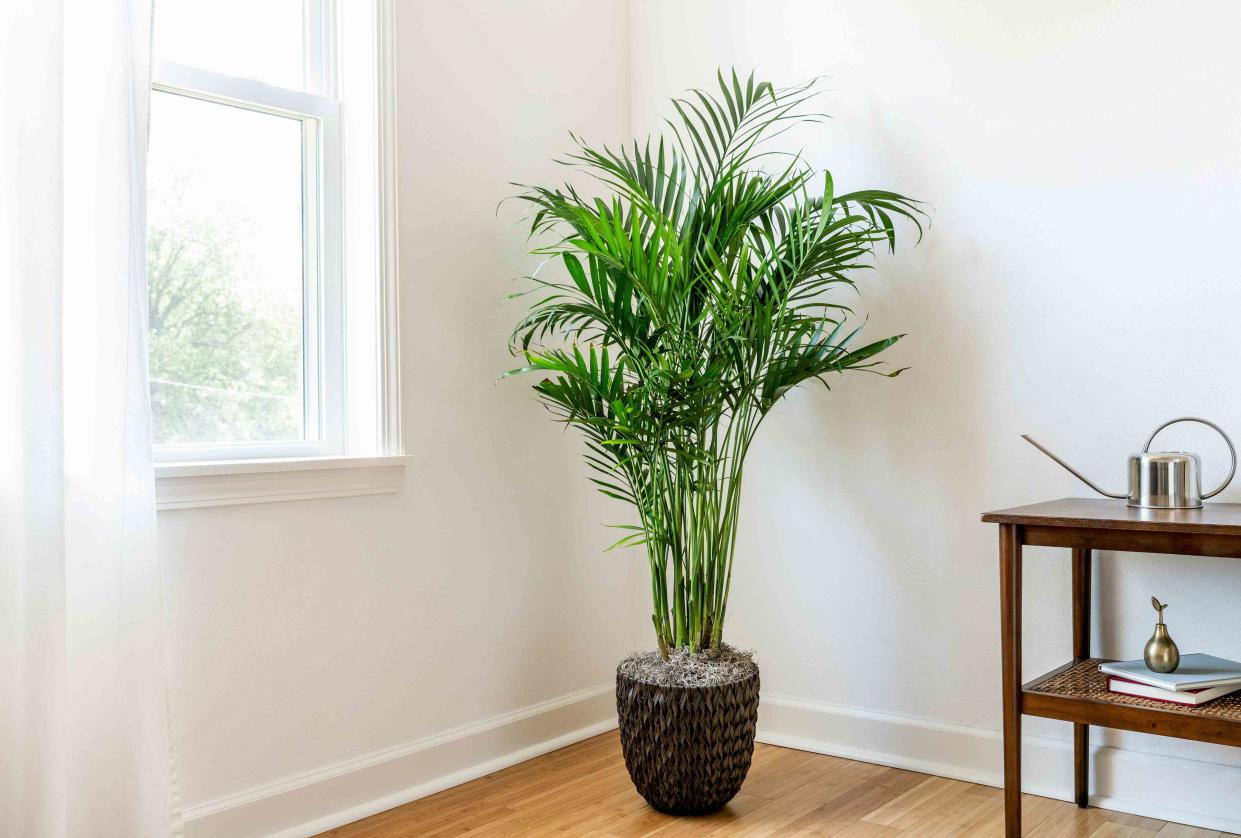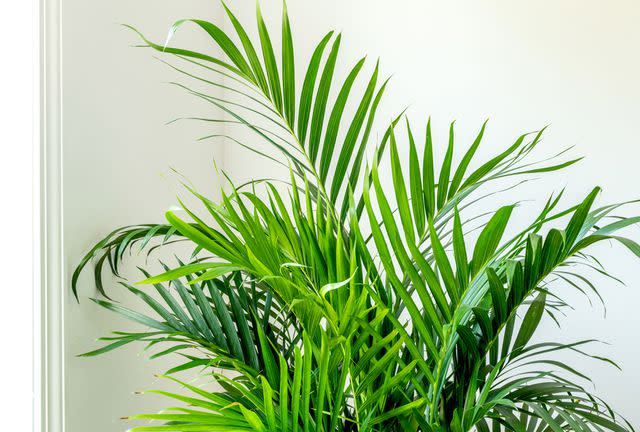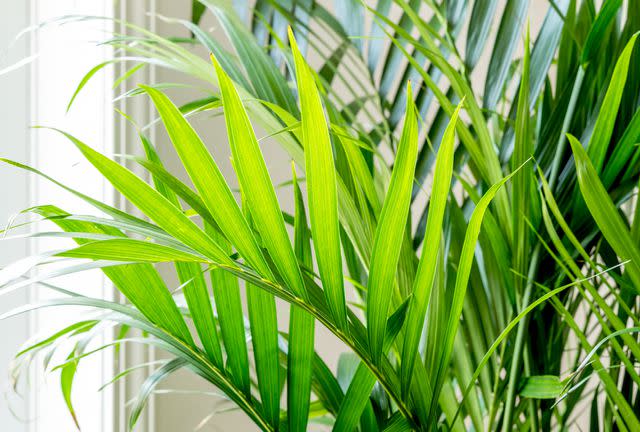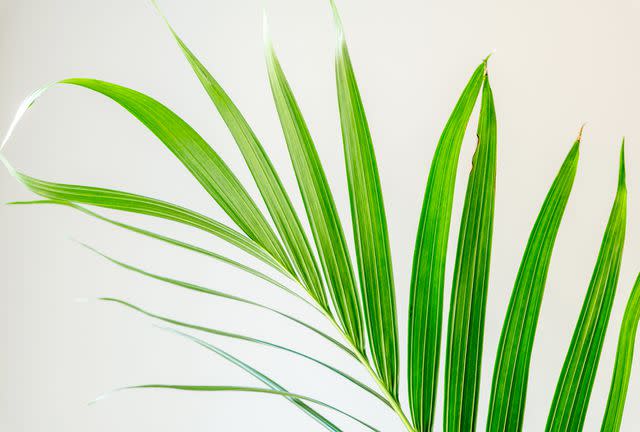How to Grow and Care for Cat Palm in Your Home

The Spruce / Adrienne Legault
Cat palm (Chamaedorea cataractarum), also called cascade palm or cataract palm, is known for its elegant fronds that grow from a cluster of slender green stems. This lush tropical houseplant grows best when planted in well-draining soil and kept in a place with bright, indirect light and temperatures between 70 and 80 degrees. Cat palms can take up to 10 years to reach their mature size of around three feet tall when grown indoors.
There are several benefits of growing cat palms in your home. Houseplants like cat palms may help improve air quality, and grouping these plants with other specimens can create a more humid microclimate. Plus, cat palms are low-maintenance houseplants that are easy for beginners to grow.
Common Name: | Cat palm, cascade palm, cataract palm |
Botanical Name: | Chamaedorea cataractarum |
Family: | Arecaceae |
Plant Type: | Perennial, Shrub |
Mature Size: | Up to 3 ft. tall indoors, 6-8 ft. tall outdoors |
Sun Exposure: | Partial |
Soil Type: | Loose, Well-drained |
Soil pH: | Neutral |
Bloom Time: | Winter, Spring |
Flower Color: | Yellow |
Hardiness Zones: | 9-11 (USDA) |
Native Area: | Mexico, Central America |
Cat Palm Care
Put cat palms in a place with bright, indirect light.
Plant in a loose, well-draining potting mix.
Water so that the soil stays evenly moist but not soggy.
Maintain temperatures between 70 and 80 degrees Fahrenheit during the day.
Feed with a balanced liquid houseplant fertilizer monthly during the growing season.

The Spruce / Adrienne Legault

The Spruce / Adrienne Legault

The Spruce / Adrienne Legault
Light
Cat palms grow best with lots of bright, indirect light. Direct morning sunlight from an east-facing window is generally okay, but harsh direct sun can burn the leaves. Rotate your plant periodically to give all the foliage enough light exposure.
Soil
Cat palms don't like "wet feet," so it's important to plant them in a loose, fast-draining potting mix that will hold moisture while allowing excess water to drain away. You can purchase a pre-made mix specifically created for palms, or make your own by combining potting mix with equal parts pine bark and perlite.
Water
Water your cat palm when the top of the soil has just begun to dry out. One of the most common issues with cat palms is root rot from overwatering, so do not water too often. Check saucers and cache pots to make sure your plant isn't sitting in excess water after watering.
Temperature and Humidity
Cat palms prefer temperatures between 70 to 80 degrees during the day and in the 60-degree range at night. Temperatures below 50 degrees can damage its foliage. This plant benefits from at least 50 percent humidity.
Fertilizer
Feed cat palms with a balanced liquid houseplant fertilizer diluted to half strength once per month starting in early spring, or when you first see new growth at the start of the season. Stop fertilizing in the fall.
Pruning
Cat palms don't need regular pruning to look healthy, but they benefit from occasional tidying up. Use clean, sharp, sterilized shears or pruners to cut back yellow, dead, or damaged fronds at the base of the plant as they appear.
Propagating Cat Palm
Cat palms are simple to propagate by dividing mature plants. You'll need clean, sharp shears or a serrated digging knife, an appropriately sized plant pot for your new divisions, fresh potting mix, and gardening gloves (optional). For very large specimens, a small pruning saw may be helpful. Here's how to divide a cat palm.
Gently remove the mother plant from its container. Examine the root ball and crown of the plant to identify clumps of stems and their roots. You can create multiple divisions from a single plant as long as the leaves on each clump are at least one foot long with the root system connected.
Use your fingers to loosen the root ball a bit, then use your shears, serrated knife, or pruning saw to cut away the clumps you'd like to propagate. Make sure to keep clusters of stems and their root systems intact.
Repot the divisions with fresh potting mix in appropriately sized containers that have drainage holes. Make sure the soil line hits the same place on the plant as it did in the original pot.
Water your divisions well. Allow their root systems to recover for a few weeks before fertilizing the plants.
How to Grow Cat Palm From Seed
Growing cat palms from seed is very slow, with inconsistent results. Leave that to the professionals and try propagating cat palms by dividing a mature plant instead.
Common Pests & Plant Diseases
Cat palms can fall prey to a few common houseplant pests, including mealybugs, scale, and spider mites that suck sap from the leaves.
Leaf spot can also affect cat palms. Prevent it by watering the soil directly or bottom watering to keep the foliage dry and less susceptible to disease. You can treat leaf spot with an organic fungicide according to manufacturer instructions, but this is usually only necessary in severe cases.
How to Get Cat Palm to Bloom
Cat palms can bloom with small spikes of tiny yellow flowers. While it's unlikely that an indoor plant will bloom, you'll have the best luck if you recreate the plant's ideal conditions and fertilize it regularly as soon as you see signs of new growth in late winter or early spring.
Bloom Months
With the proper conditions, cat palms can bloom in late winter or early spring.
How Long Does Cat Palm Bloom?
In nature, cat palm flowers typically last for a couple of weeks before setting fruit. However, a male and a female plant are required for a plant to fruit.
Common Problems With Cat Palm
Cat palms are pretty easy to care for, but you'll want to keep an eye out for signs of problems. Here are some common issues to watch for and how to save a cat palm that is growing poorly.
Brown Leaf Tips
Underwatering and low-humidity conditions can both cause cat palm leaf tips to turn brown. Water your plant when the soil surface has just begun to dry out and create more humid conditions. Brown tips on lower leaves can be a sign of overfertilizing.
Leaves Turning Yellow
Yellowing leaves are a common sign of overwatering or underwatering in houseplants, including cat palms. If you suspect overwatering is the issue, cut back on watering until the soil dries out completely, then water the plant well. Only water when the top of the soil has just begun to look dry. Yellow spots on translucent leaves may be a sign of potassium deficiency.
Leaves Dropping
Overwatering and underwatering can both cause leaves to fall off. Check the soil moisture and adjust your watering routine accordingly.
Frequently Asked Questions
Do cat palms need direct sunlight?
Cat palms grow best in bright, indirect light. A few hours of direct sun in the morning is okay, but harsh afternoon sunlight can burn your plant's leaves.
Do cat palms like being misted?
Cat palms like humidity levels over 50 percent, but misting doesn't recreate the humid environment many houseplants need and can even create the conditions for plant diseases to take hold. Instead, run a humidifier in the room with your cat palm, or group it with several other humidity-loving plants to create a microclimate with more moisture in the air.
Do cat palms like to be rootbound?
Cat palms are slow-growing plants, especially when kept indoors. They also don't respond well to having their roots disturbed, so it's better to let them become slightly potbound before repotting. Plan to repot your cat palm every three years or so.
Read the original article on The Spruce.

